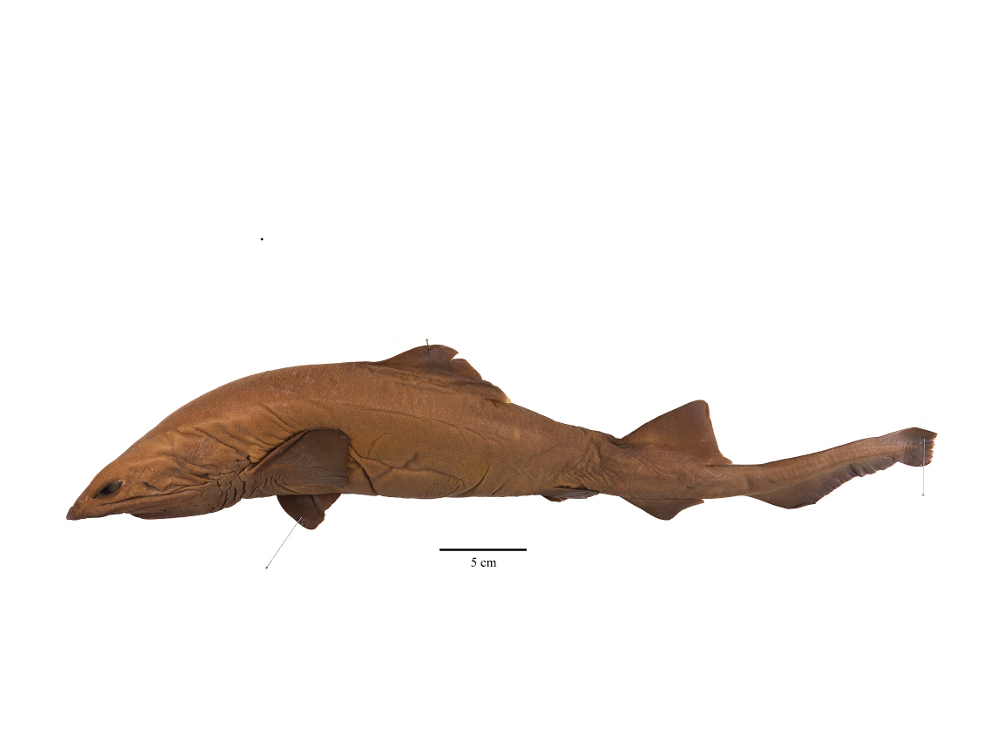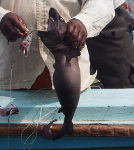Planonasus parini
Weigmann, Stehmann & Thiel, 2013
Dwarf False Catshark
Classification: Elasmobranchii Carcharhiniformes Pseudotriakidae
Reference of the original description
Planonasus parini n. g. and n. sp., a new genus and species of false cat sharks (Carchariniformes, Pseudotriakidae) from the deep northwestern Indian Ocean off Socotra Islands. Zootaxa, 3609(2), 163–181
Planonasus parini n. g. and n. sp., a new genus and species of false cat sharks (Carchariniformes, Pseudotriakidae) from the deep northwestern Indian Ocean off Socotra Islands. Zootaxa, 3609(2), 163–181
Description by Simon Weigmann (2013):
University of Hamburg, Biocenter Grindel and Zoological Museum, Martin-Luther-King-Platz 3, 20146 Hamburg, GermanyCitation: Planonasus parini Weigmann, Stehmann & Thiel, 2013: In: Database of modern sharks, rays and chimaeras, www.shark-references.com, World Wide Web electronic publication, Version 12/2025
Please send your images of "Planonasus parini" to info@shark-references.com

Planonasus parini Weigmann, Stehmann & Thiel, 2013; Holotype: ZMH 25895, female, 534 mm TL fresh, © Dr. Simon Weigmann, Elasmobranch Research Laboratory, Hamburg, Germany

Planonasus parini Weigmann, Stehmann & Thiel, 2013; Holotype: ZMH 25895, female, 534 mm TL fresh, © Dr. Simon Weigmann, Elasmobranch Research Laboratory, Hamburg, Germany
Common names
 Dwarf False Catshark
Dwarf False Catshark
 Dwarf False Catshark
Dwarf False Catshark
Short Description
Planonasus parini is the only described member of deep-water pseudotriakid genus Planonasus. It is characterized by a soft, rather deep, and stout to slender and elongated body and a long head; the snout is moderately long, bell-shaped and flattened; the spiracles are large and oriented nearly vertically; the mouth is very large and angular; each jaw has about 110-120 tooth rows, the upper teeth are mostly tri- to pentacuspidate, whereas the lower teeth are mostly comb-like; the labial furrows and the anterior nasal flaps are short, the internarial space is broad; the entire roof of mouth is densely set with oral papillae of distinct size; the first dorsal fin forms a long and low triangle with rounded upper and narrowly pointed rear apex, its base is situated totally in front of pelvic-fin base; the second dorsal fin is much higher than first dorsal fin and forms an uneven triangle with narrowly rounded upper apex, its origin is over pelvic-fin insertions; no interdorsal ridge is present; the anal fin is small and low, its origin is behind that of second dorsal fin; a precaudal pit is not present; the caudal peduncle is relatively short and the axis is raised upwards; the dorsal caudal margin is short, not undulated, and with a keel of somewhat enlarged denticles at front edge. The coloration is plain dusky with fins and ventral snout somewhat darker and with free rear tip of first dorsal fin marked white. Planonasus differs from the two other pseudotriakid genera Gollum and Pseudotriakis by the presence of oral papillae, the absence of nicitating eyelids, a longer head, an intermediate prenarial snout length, an intermediate number of tooth rows per jaw, a first dorsal fin of intermediate height and length and with white free rear tip, a caudal peduncle of intermediate length, and fewer vertebrae.
Planonasus parini is the only described member of deep-water pseudotriakid genus Planonasus. It is characterized by a soft, rather deep, and stout to slender and elongated body and a long head; the snout is moderately long, bell-shaped and flattened; the spiracles are large and oriented nearly vertically; the mouth is very large and angular; each jaw has about 110-120 tooth rows, the upper teeth are mostly tri- to pentacuspidate, whereas the lower teeth are mostly comb-like; the labial furrows and the anterior nasal flaps are short, the internarial space is broad; the entire roof of mouth is densely set with oral papillae of distinct size; the first dorsal fin forms a long and low triangle with rounded upper and narrowly pointed rear apex, its base is situated totally in front of pelvic-fin base; the second dorsal fin is much higher than first dorsal fin and forms an uneven triangle with narrowly rounded upper apex, its origin is over pelvic-fin insertions; no interdorsal ridge is present; the anal fin is small and low, its origin is behind that of second dorsal fin; a precaudal pit is not present; the caudal peduncle is relatively short and the axis is raised upwards; the dorsal caudal margin is short, not undulated, and with a keel of somewhat enlarged denticles at front edge. The coloration is plain dusky with fins and ventral snout somewhat darker and with free rear tip of first dorsal fin marked white. Planonasus differs from the two other pseudotriakid genera Gollum and Pseudotriakis by the presence of oral papillae, the absence of nicitating eyelids, a longer head, an intermediate prenarial snout length, an intermediate number of tooth rows per jaw, a first dorsal fin of intermediate height and length and with white free rear tip, a caudal peduncle of intermediate length, and fewer vertebrae.
Distribution
Planonasus parini is known only from off the Socotra Islands near the Horn of Africa. Only three specimens are known.
First record: Sri Lanka, Southwest Bay of Bengal. 55 cm TL, between 300 m and 600 m depth off Trincomalee Outer Harbour near Norway Inlet (08° 29'.136 N, 81° 14'.783 E).[25355] Source: www.gbif.org
Planonasus parini is known only from off the Socotra Islands near the Horn of Africa. Only three specimens are known.
First record: Sri Lanka, Southwest Bay of Bengal. 55 cm TL, between 300 m and 600 m depth off Trincomalee Outer Harbour near Norway Inlet (08° 29'.136 N, 81° 14'.783 E).[25355] Source: www.gbif.org
Human uses
Human uses are unknown.
Human uses are unknown.
Biology
The biology of Planonasus parini is unknown. However, based on the soft fins, skin, and musculature, the species is thought to be a sluggish and inactive shark of nearly neutral buoyancy such as Pseudotriakis microdon. The shape of the caudal fin and the moderately elongated body form are typical for slow-swimming sharks that live near the bottom. Planonasus parini might be yolk-sac viviparous and oophagous like Pseudotriakis microdon and Gollum attenuatus. No information is available about the feeding habits of Planonasus parini. However, other pseudotriakids feed predominantly on bony fishes, sharks, molluscs, and crustaceans.
The biology of Planonasus parini is unknown. However, based on the soft fins, skin, and musculature, the species is thought to be a sluggish and inactive shark of nearly neutral buoyancy such as Pseudotriakis microdon. The shape of the caudal fin and the moderately elongated body form are typical for slow-swimming sharks that live near the bottom. Planonasus parini might be yolk-sac viviparous and oophagous like Pseudotriakis microdon and Gollum attenuatus. No information is available about the feeding habits of Planonasus parini. However, other pseudotriakids feed predominantly on bony fishes, sharks, molluscs, and crustaceans.
Size / Weight / Age
Planonasus parini is a small shark species that reaches at least 534 mm TL. The smallest known specimen is a juvenile male of 339 mm TL. The largest known specimen of 534 mm TL is a female that is probably immature or at most adolescent due to its small and compact ovaries. A maturing size of 490 to 560 mm TL is specified for a probably closely related, undescribed pseudotriakid species (Compagno et al. 2005 [534]).
Planonasus parini is a small shark species that reaches at least 534 mm TL. The smallest known specimen is a juvenile male of 339 mm TL. The largest known specimen of 534 mm TL is a female that is probably immature or at most adolescent due to its small and compact ovaries. A maturing size of 490 to 560 mm TL is specified for a probably closely related, undescribed pseudotriakid species (Compagno et al. 2005 [534]).
Habitat
bathydemersal; marine; all three specimens were collected from the insular slope at depths between 560 and 1120 m.
bathydemersal; marine; all three specimens were collected from the insular slope at depths between 560 and 1120 m.
Dentition
strong heterodonty between upper and lower jaw; upper jaw with about 110 to 115 tooth rows; upper teeth tri- to pentacuspidate with conically elongated and pointed median main cusp and weak lateral cusplets; only few posterior to commissural tooth rows with weakly comb-like, multicuspidate teeth that each have nearly equally sized cusplets; lower jaw with about 115 to 120 tooth rows; lower teeth arranged in diagonal parallel rows; most lower teeth broad, low, and comb-shaped with usually five cusps.
strong heterodonty between upper and lower jaw; upper jaw with about 110 to 115 tooth rows; upper teeth tri- to pentacuspidate with conically elongated and pointed median main cusp and weak lateral cusplets; only few posterior to commissural tooth rows with weakly comb-like, multicuspidate teeth that each have nearly equally sized cusplets; lower jaw with about 115 to 120 tooth rows; lower teeth arranged in diagonal parallel rows; most lower teeth broad, low, and comb-shaped with usually five cusps.
Remarks
shark-references Species-ID=13119;
shark-references Species-ID=13119;

















